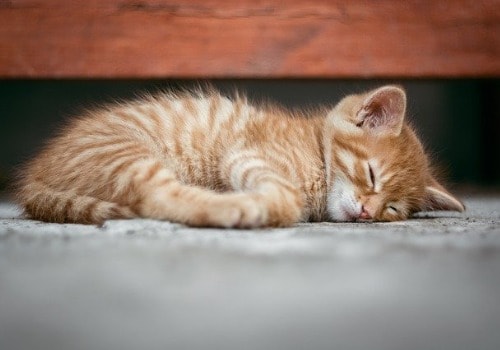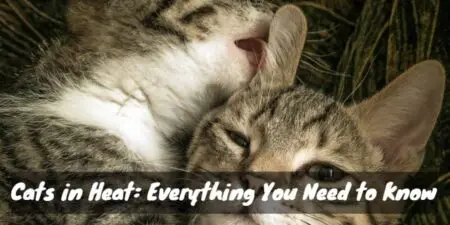While cat litter sizes can vary between cats, on average, most cats have about three to five kittens per litter. Because a cat can technically get pregnant every three months or so, a single female cat can give birth to more than two hundred kittens in her lifetime!
Various factors can influence your cat’s litter size, but in general, a pregnant cat means your family is about to grow by anywhere between three and nineteen new kittens! Spaying and neutering your pets is the only real way to prevent cat pregnancies, but if raising kittens is something you’re excited about, it can be a great way to expand your family with several adorable new faces.
How Young Is Too Young?
Most cats live, on average, to be between 13 and 15 years old. However, female cats can become pregnant as early as four months old and, unlike humans, never go through menopause. This means that your cat can become pregnant from the time she is four months old throughout the rest of her life.
Also, unlike humans, cats show no sign of slowing down as they age. This means that not only do they not stop getting pregnant as they age, but there are no real health risks associated with pregnancy in older vs. younger cats. A ten, eleven, or twelve-year-old cat is just as likely to get pregnant and carry the litter to term as is a one, two, or three-year-old cat!
Unless your cat is spayed, she is perfectly capable of having a litter four times a year for an average of fifteen years. The kittens can quickly add up, especially if you live in an area with several other cats, and the prospect can become daunting.
How Many Kittens Can My Cat Have?

As mentioned above, the average litter size is between three and five kittens. However, that number can vary wildly between different animals. The largest litter recorded was 19 kittens, born in the UK in 1970, and some litters may be as small as one or two kittens.
If your cat is pregnant, a veterinarian can generally give you a good idea of how many kittens both you and your mama cat should expect. Because cats’ gestation periods are so short, a vet can confirm pregnancy as early as 16 days. However, if you’re looking for an estimation of your cat’s litter size, you may want to consider getting an X-ray instead.
Your cat’s size, breed, and health can also play a major role in how large a litter she’ll be able to have. In general, smaller cats tend to have smaller litters. This is just a simple matter of how much room a full litter has to grow inside a very small cat as opposed to inside a larger animal.
In regards to breed, certain breeds of cats tend to produce larger litters. Persian cats and similar breeds tend to have smaller litters. Siamese cats and other breeds that develop along the same lines tend to have larger litters, generally in the five and up range.

Health can also greatly impact both the size and strength of your cat’s litter. Healthier cats produce larger, healthier litters. If your cat is a recent rescue, or if she’s been having some health issues, you run the risk of having a smaller or even a partially stillborn litter.
Specific health concerns may also impact your cat’s ability to carry a large litter. Feline distemper can result in a drastic reduction of live-born kittens and can even wipe out an entire litter before it’s born. FIP (feline infectious peritonitis) can greatly decrease a cat’s ability to get pregnant and can also hurt the litter of an already-pregnant cat.
As a rule, if you suspect your cat is pregnant, it can’t hurt to get her to the veterinarian as soon as possible. If your cat is healthy, you should be able to welcome a full litter in less than three months. If your cat’s health is at risk, however, both the mama cat and the kittens may need closer surveillance to make sure that they’ll be safe.
The final two factors to consider when estimating the litter size are the age of the cat and the health of the sire. If your cat is more of an outdoors animal, you may not know that much about the male cat involved in the pregnancy, but his health and genetics can influence the size of the litter as well. Male cats tend to have more issues with fertility, which can usually result in a smaller litter size or fewer number of healthy kittens.
Finally, the age of the cat can sometimes influence the size of the litter. While it is true that cats can get pregnant at virtually any age, their first litters tend to be their smallest. A cat’s first litter will usually be between one and three kittens, but that number can quickly increase with each successive litter.
A lot of these factors are out of your control when it comes to dealing with a pregnant cat. You probably won’t have a say in the sire, the breed of cat, or how many litters your female cat has had before this most recent pregnancy. However, no matter the size of the litter, your primary concern as a cat owner should be making sure your cat is happy and healthy throughout her pregnancy.
Family Planning

While kittens are undeniably adorable, you may not necessarily be ready to deal with the extra time and effort required to care for an entire litter. The best way to keep your cat from getting pregnant is to get her spayed.
As mentioned above, cats usually reach sexual maturity between four and six months of age. This is when most veterinarians recommend spaying. The procedure is perfectly safe for older cats as well if you’ve just rescued or purchased a cat with a few more years under her belt.
If you have any male cats, most veterinarians strongly recommend having them neutered, as well. This will not only protect any cats that you haven’t had spayed yet but will also keep your tomcats from bothering other cats in the area.
Some people claim that because their cats are indoor pets, they don’t need to have them fixed. While keeping your cats indoors at all times can go a long way toward keeping them from getting pregnant, it’s not an entirely foolproof method.

For this reason, no matter how indoor or outdoor your cats generally are, if you don’t want to have to raise a litter of kittens, your male and female cats will need to be sterilized. Sterilizing cats will keep both your own and your neighbor’s cats safer and healthier in the long run and can prevent a lot of headaches from unwanted feline pregnancy.
On the other hand, if you are interested in raising a litter of kittens – or if your cat has become pregnant and you’re not opposed to the idea of having some cute little kittens crawling around – make sure you keep your cat healthy and strong throughout her pregnancy. Take her to the vet the instant you suspect any health issues, and generally try to keep her comfortable and safe until her kittens are due.
In general, consult with your veterinarian before putting your pregnant cat on any new medication, as well as before continuing the usual flea or tick prevention medications. Make sure you provide a warm, clean “queening” place for your cat to give birth, somewhere private and enclosed, and let her get comfortable with the place long before she’s expecting her kittens.
Finally, make sure your cat is getting enough nutrition during her pregnancy. As in human pregnancies, a pregnant cat has to provide enough nutrients for any number of smaller cats, so she may eat more while pregnant than she has previously, Make sure her food is nutrient-rich, and make sure that she has enough to be able to support herself and all the kittens inside her.
Conclusion
A pregnant cat can be a bit of a shock. Sometimes, it can even be frightening if you’re not sure how you’re going to find the time or energy to take care of a bunch of tiny new kittens. However, if your cat is pregnant, the best thing you can do is help them be healthy and comfortable until she’s ready to deliver her babies.
The number of kittens varies based on breed, size, health of both cats involved, and how many litters the female cat has had in the past. However, since age isn’t really a barrier on either end of the spectrum, nearly any cat can produce between one and nineteen kittens every three months for most of their lives. If you don’t want your cat to give you kittens, the best and often the only surefire method of prevention is spaying and neutering any cats you have within your home.
Kitten Care: How Many Kittens Are Born in 1 Litter? (Video)
"In ancient times cats were worshipped as gods; they have not forgotten this."
-- Terry Pratchett





